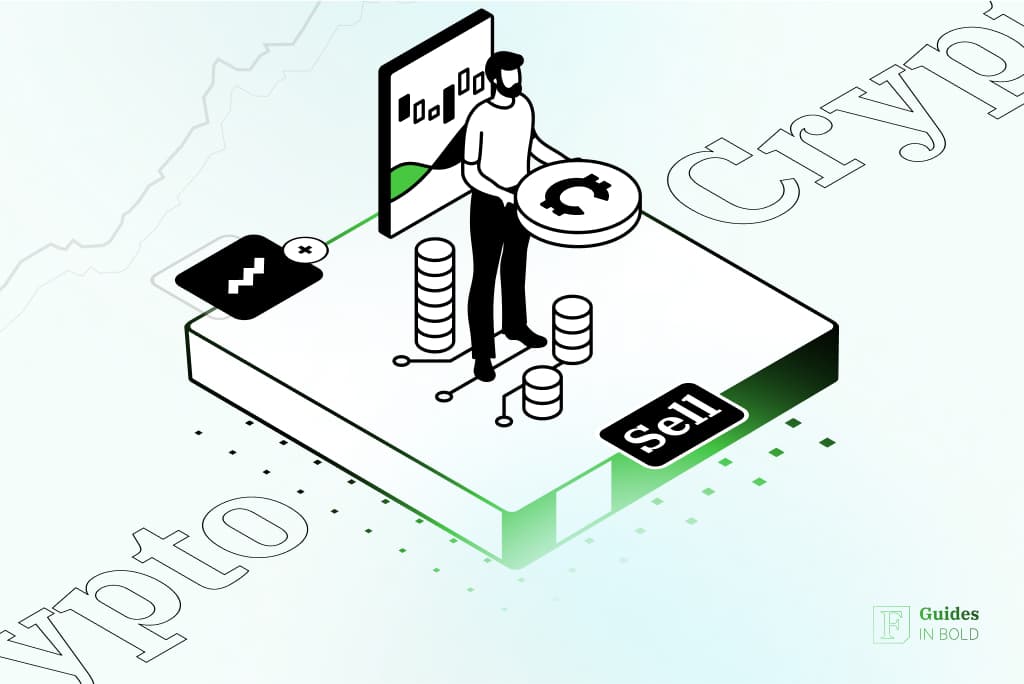Knowing when to sell crypto is just as important as knowing when to buy it, given the market’s inherent volatility and regulatory implications. While no trader is infallible, there are some strategies that can help you recognize the right moment to sell. In this guide, we present some tips on when to sell your crypto holdings.
When to sell crypto?
Deciding when to sell crypto — and how much to sell — depends on a number of factors. For example, you ought to consider your current financial situation, your investment goals and time window, your current risk tolerance, and so on.
It must be stressed, though, that trying to time the market perfectly with any consistency is virtually impossible due to its inherent volatility. As an answer to this volatility, it is much wiser to craft a clearly defined trading plan in advance, paying special attention to your exit strategies.
How you go about this will vary based on the factors mentioned above. Some traders, for example, like selling some of their holdings each time they reach a specific short-term goal. Others, on the other hand, sell enough to make their initial desired profit and then continue holding the rest.
Indeed, if your investments have generated a lot of profit, it is often advisable to sell while the project still has long-term potential. By doing so, you can secure your profits while not sacrificing long-term growth. What’s more, you can use some of the secured profits to invest in some other assets and create a stronger, more diverse portfolio.
However, there are some situations when it is highly advisable to sell no matter what your investment goals are. Some of them include:
- The crypto project you invested in is failing;
- Negative publicity surrounding the project;
- Your portfolio needs rebalancing;
- Tough financial situations.
1. The crypto project you invested in is failing
Some new tokens create a lot of buzz and even generate a lot of revenue. However, many also stall quickly and lose all momentum. Consequently, they are likely to drop in value and become virtually worthless. Therefore, if you see that the projects you invested in are not delivering on their promises and that investor confidence in them is only diminishing, it is probably a good idea to jump ship and sell.
2. Negative publicity surrounding the project
News travels quickly in the crypto market — especially bad news. There have been numerous cases of, for instance, social media influencers ruining their crypto projects overnight. Therefore, if you notice that your investments are making crypto headlines for bad reasons, it is likely time to sell.
3. Your portfolio needs rebalancing
Selling some crypto to rebalance your portfolio is often a good idea, especially if your portfolio is lacking in some other types of assets. That is, since crypto is highly volatile, your portfolio might become riskier if you keep relying on crypto alone to carry you to success.
4. Tough financial situations
The purpose of investing is to make a profit and make your life easier. Consequently, if selling your crypto helps reduce debt, for example, selling is a good course of action. The same goes for unexpected issues like medical bills, job loss, etc.
How to sell crypto smart
As discussed, learning how to sell crypto is all about learning how to make calculated, well-informed decisions. Some of the most common crypto-selling strategies involve:
- Planning your sales ahead: Try to set specific price levels at which to take profits (e.g., when your holdings double in value). This will give you a sense of structure and help you avoid emotional reactions during volatile market moves;
- Selling only a portion of your holdings: Instead of selling everything at once, you can also sell in phases. For example, you can decide to sell 10% of your holdings when your assets reach a certain value, and then sell 15% when they reach an even higher one, etc. This approach ensures you keep profits while still allowing you to profit even more in case the price keeps rising;
- Dollar-cost averaging: Dollar-cost averaging involves regularly investing a fixed amount of money, regardless of crypto price fluctuations. You can reverse this and make it so that you sell a fixed amount at specific time intervals. This can be a solid approach if you prefer less proactive portfolio management;
- The House Money strategies: If your investments are performing exponentially well, you can resort to what is called the House Money strategy. In short, this strategy boils down to securing your initial investment and leaving the rest in your wallet. For example, if you started with $1,000 and turned it into $5,000, you might sell enough to return the initial $1,000 in cash, leaving the remaining $4,000 to see how they perform over time;
- The Moonbag strategy: This strategy is similar, as it involves selling most of your holdings, say 95%, and holding onto the rest. The idea is simple: You get most of your profits while leaving a small piece of your holdings in the game just in case the token blows up in value. The small remaining portion is what is referred to as the Moonbag. This is a solid exit plan if you are not pressed for money and feel like 5% or so of your holdings will not make that big of a difference.
When not to sell crypto
One of the most important tips when deciding whether to sell crypto is to ensure you’re not just selling for the sake of it or because you’re hyped about a new opportunity. This, of course, applies to all investments, but it’s especially important when it comes to cryptocurrencies, as they are among the most volatile assets, meaning their prices often go up and down quite chaotically.
One of the most common investing mistakes is panic selling during a downturn. This logically correlates with another observable pattern: many people buy crypto when their excitement about it is at its highest.
Such decisions most often result in losses, so always ask yourself why the price is down before impulsively selling your holdings. It is not always the case that the project is failing since, as mentioned, the market tends to oscillate in general due to a number of reasons. In other words, always ensure that you sell based on extensive research and high confidence, not on fear or other emotions.
Additionally, consider the tax implications. For example, selling crypto can trigger capital gains taxes, as in the US.
The bottom line
The crypto market is highly volatile and unpredictable, meaning that even veteran investors are not always able to time their sales right. To mitigate some risks associated with market timing, it’s essential to stay patient, create a well-structured investment strategy, and avoid common mistakes that often arise from emotional investing.
While there’s no one universal formula for success, the tips presented above can help you spot some key signs indicating that the time to sell has come. It also bears mentioning once more that crypto, like any other investment, always comes with risks, so you should never invest what you are not willing to lose.
Disclaimer: The content on this site should not be considered investment advice. Investing is speculative. When investing, your capital is at risk.
FAQs on when to sell crypto
When to sell crypto?
A good time to sell crypto will depend on several factors, including your investment goals, profit targets, and broader market conditions.
When should you not sell crypto?
There are many situations when selling crypto is not advisable. For example, selling based on emotions such as panic, selling during a flash crash, or selling without having a clear investment plan.
How to sell crypto?
You can sell your crypto on your crypto exchange by selecting your assets and choosing the “sell” option.
Where to sell crypto?
You can sell crypto on the same crypto exchange you used to buy it.
What is a stop-loss sale?
A stop-loss sale is an order type that has your crypto exchange automatically sell your assets if their value drops below a pre-specified price. As such, it is a risk management tool that prevents major losses.




